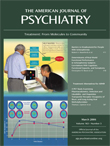Improving the Accuracy of the Diagnosis of Schizophrenia by Means of Virtual Reality
Abstract
OBJECTIVE: The authors’ goal was to improve the diagnosis of schizophrenia by using virtual reality technology to build a complex, multimodal environment in which cognitive functions can be studied (and measured) in parallel. METHOD: The authors studied sensory integration within working memory by means of computer navigation through a virtual maze. The simulated journey consisted of a series of rooms, each of which included three doors. Each door was characterized by three features (color, shape, and sound), and a single combination of features—the door-opening rule—was correct. Subjects had to learn the rule and use it. The participants were 39 schizophrenic patients and 21 healthy comparison subjects. RESULTS: Upon completion, each subject was assigned a performance profile, including various error scores, response time, navigation ability, and strategy. A classification procedure based on the subjects’ performance profile correctly predicted 85% of the schizophrenic patients (and all of the comparison subjects). Several performance variables showed significant correlations with scores on a standard diagnostic measure (Positive and Negative Syndrome Scale), suggesting potential use of these measurements for the diagnosis of schizophrenia. On the other hand, the patients did not show unusual repetition of response despite stimulus cessation (called “perseveration” in classical studies of schizophrenia), which is a common symptom of the disease. This deficit appeared only when the subjects did not receive proper explanation of the task. CONCLUSIONS: The ability to study multimodal performance simultaneously by using virtual reality technology opens new possibilities for the diagnosis of schizophrenia with objective procedures.



